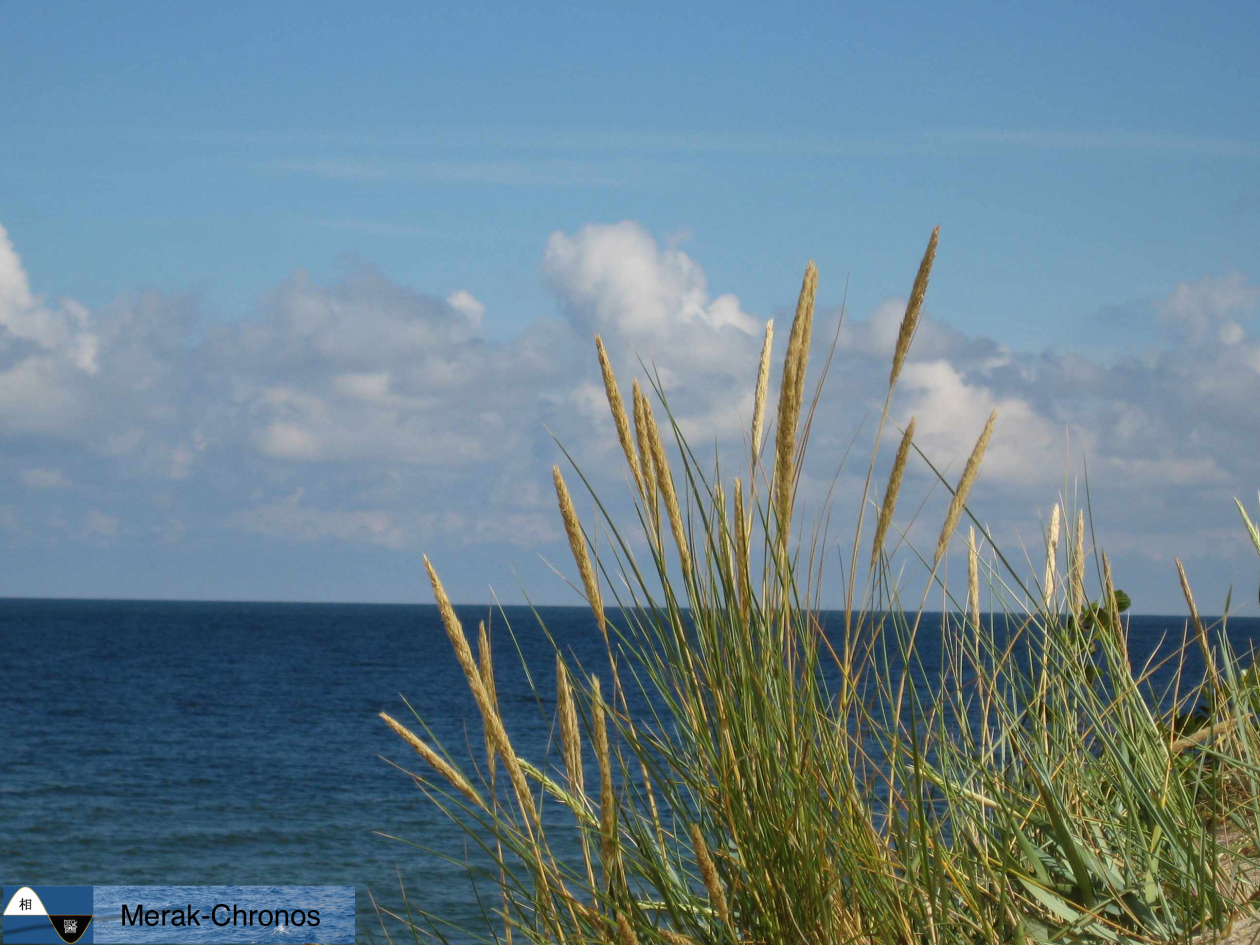|
Chronobiological Factor In Oncology
|
|
Each man’s growth, development and aging pass according to the certain laws. Modern physiology takes into account only its general tendencies. However there’re finer mechanisms that in each specific case influence them. They were known and described in ancient cultures.
For example, in traditional Chinese medicine (TCM) the time factor (“time energy”) was highlighted. Let’s consider information on “time energy” available to us from traditional Chinese medicine (TCM) in a view of modern knowledge.
Without going into details of S. Hahnemann’s “vital forth” and TCM “energy” (Qi, Chee etc.) terms, we note their great resemblance. It is as follows:- the main role of “energy”/ “vital force” in majority of processes passing in human body in normal condition and in pathology;- active interaction of “energy”/ “vital force” with external phenomena and objects;- possibilities of health recovery by influence on “energy”/ “vital force”. This includes informational influence.There were several subdivided kinds of “energy” in TCM. We know energies of breath, ancestors’, psychoemotional etc. According to some estimations about 80% of total balance was assigned to “time energy”.
The fact of dominating role of “time energy” is quite obvious. None of the therapy systems, none of the methods of influence on human organism can’t stop time flow including aging. That’s why understanding of fine processes accompanying development of pathology in time is very important aspect of every therapy. Regarding to prolong and slow acting diseases (oncology in particular) time factor can turn out to be dominating. Let’s examine this question in detail using the knowledge of TCM.
One of the fundamental information resources dedicated to “time energy” is Chinese calendar. There’re four components there: energies of year, month, day and hour (actually, two-hour period). Each time unit is correlated to its symbolic animal. Nowadays almost in all calendars and in many of the mass media character of current year is presented in the form of symbolic animal. 2003 is a Sheep year, 2004 – a Monkey one. There are 12 symbolic animals. Each animal has 5 types (according to Chinese metaphysic five phases). For example, 2004 is a year of wood monkey. In 12 years’ time Monkey year will recur, but that time monkey will be fiery, i.e. 2016 will be fiery monkey year. The whole cycle includes 60 elements (5 times 12 animals). Thus, recurrence of wood monkey will be in 2004 + 60 = 2064 year.
Today nearly each person knows what symbolic animal year is his year of birth. But interpretation of this knowledge has little in common with the serious information Chinese calendar contains.
Let’s examine the influence of year’s “time energy” on cyclic processes in the human body.
So, Chinese calendar “breaks up” our life into 12-year periods. Each period is characterized by its physiological features, common for all people. Between these periods there’s a transition concerned with active rearrangement of an organism. |
|

Figure 1.
In fig.1 there is a diagram of human organism’s relative energy resources presented according to years of life, calculated with “Chronos” program. Program uses Chinese calendar. That part of whole energy potential is implied by energy resource which person can use for outward problems solving (social, family etc.). It’s presumed that whole energy potential has two components: the first is used to maintain necessary vital (physiological) functions, another one – to contact with outward world. It’s obvious that such a model is very reductive. But it helps to understand the main stages of human life and their energetic features.
Diagram on fig.1 is common for all people. Let’s analyse it.
Right after child’s birth all energy resources are used for his growth. As he grows up resources appear that can be used for family business, studying etc. The lowest potential is approximately up to 3 years old. In this period children most often fall ill. At the age of 12 “rearrangement” in organism starts. This rearrangement requires resources, that’s why at the puberty age the first signs of chronic diseases may appear (manifestation of intrauterine intoxications). After this a period of growth of energy potential starts – in the childhood one was in poor health and after 12-15 years old “one’s overgrown his diseases”.
The age from 12 to 24 years is the period of human’s active development. His potential still grows. But at the age of 24 the next rearrangement starts that requires some resource. Therefore in this period some reduction of energy potential is observed. General resources at this time are large and such reconstruction remains unnoticed. However more detailed analysis reveals it. For instance, in the common interpretation after the age of 24 years person “steadies”.
The period from the age of 24 to 36 is favorable enough. Potential is high, but tendencies to its recession begin to be observed. At the age of 36 rearrangement is not always observed, though chronic diseases appear in many people at this time. If we analyse prevalence of oncologic diseases its raise will be noticed in this age group.
The period from the age of 36 to 48 is marked by obvious recession of potential in most people. Decrease of activity is observed in many rates. The age of 48 is the start of serious hormonal reconstruction. Almost all people begin to understand that aging is not a fable. Old chronic diseases exacerbate and new ones appear. The rise of oncologic diseases’ prevalence is observed.
The age from 48 to 60 is marked in most people by active aging. The most serious recession is at the age of 60. Death-rate greatly increases at this age.
The period from the age of 60 to 72 is similar to the time from child’s birth to the age of 12. Only the abilities of organism are not the same. Injuries in systems, organs and tissues have accumulated. As we have mentioned, children ill mostly till 3 years old. Consequently the age from 60 to 63 is characterized by the highest mortality. Children “overage” their diseases after the age of 12-15. That’s why after the age of 72-75 survival-rate greatly increases. Many people suffering during several years from serious chronic diseases begin to complain less. Complaints lessen both in frequency and in intensity.
There’s the next rearrangement at the age of 84 but it’s not so noticeable (similar to the age of 24). On a background of general recession age group of 84 ± 1 year is marked with local death-rate rise.
Real life interval of a modern person in economically developed countries could be 96 years. This is the period of more serious regular rearrangement up to which people could live possessing appropriate knowledge.
Absolute man’s lifetime is 120 years – two times 60 years. Few people got past this point. Although there are no principal restrictions on overcoming this age too.
System approach to human’s organism and its diseases shows that oncology is not independent nosologic form, but a stage of pathological process. The more prolonged the disease is and the less adequate therapy is the more likelihood of oncologic process onset. “Year energy” of Chinese calendar considered above describes slow processes of human organism’s rearrangement – for a year or a longer period. When a man is not prepared enough for this rearrangement slowly developing pathology arises, which may stimulate growth of the tumor. After rearrangement completion restoration processes of some systems, organs and tissues are observed. In a certain way one could speak about self-recovery (rejuvenation) periods.
In other words on the basis of TCM data we can speak about (biorhythmological) phases of pathologic process’s development. There are phases of pathologic process’s acceleration, slowing down and phase of rehabilitation (it’s more correct to speak not about rehabilitation, but about temporary self-compensation – for example, a man has been in the Cancerosinum 1 stage for a long time). Self-rehabilitation potential is fixed by energy resources of the organism and by the stage of its affection by the moment of rise of energy potential. Consequently, therapy effectiveness will depend on type of phase when pathologic process has manifested.
Knowledge of mentioned above cycle allows to organize therapy correctly and prognose its results. For instance if a man falls ill at the beginning of “energy recession” it points at significant deficiency of the resources of his organism. Illness is likely to be prolonged and therapy – to be rather complicated.
On the contrary, if the disease revealed itself in the raise phase the treatment may be quick and easy enough (in these phases “miraculous” healing cases take place which every doctor has in his practice). That’s why analysis of clinical cases must take into account biorhythmological phase. Ignoring of this moment can give improper evaluation of therapy tactic or effectiveness of medicines.
For an example of analysis of different clinical cases let’s refer to John H. Clarke’s book “The cure of tumours by medicines with especial reference to the cancer nosodes”. The book contains papers from Congress dedicated to homeopathic treatment of oncological diseases which was held at the beginning of previous century.
Different cases of oncological patients’ cure by homeopathic drags are described there. Let’s read: at p. 4 – female, 52 years old, at p. 6 – female at the age of 75, at p. 13 – male at the age of 75, at p. 22 – female 64 years old, at p. 24 – male at the age of 29 – this is not a complete list of cured patients. If we analyse their age taking into account the diagram presented above we’ll see that all patients were in favorable biorhythmological phase.
An interesting case is described at p. 19-21. A male consulted a doctor in 1921 at the age of 57 on account of rectal cancer. Before this visit he underwent course of radiotherapy. After homeopathic therapy prescription patient’s condition became somewhat better. In this faintly stable condition disease continued for about three years. At the age of 60 relapse of the disease occured. Continued homeopathic treatment wasn’t effective and a decision to undergo another radiotherapy course was made. After this homeopathic treatment was continued. In 1926 the patient’s condition began significantly improve. In this case one can note that disease arose at the beginning of “energy recession” – see diagram. During this phase therapy didn’t lead to radical results. Moreover, at the lowest point of diagram, at the age of 60 the disease strengthened. At the age of 62 (raise phase) significant improvement of condition was attained.
The cycle examined above – “year energy” of Chinese calendar – is not the only one that determines the likelihood of onset and course of severe pathological processes. But it’s common for all people. In “Chronos” program calculations for two more individual cycles are made.
Individual cycles describe additional periods of fluctuations of a man’s “energy” system’s resources. Depending on amplification or compensation with one cycle another one periods of more or less “recession” in a certain person appear. In the case of simultaneous heightening of potential on several cycles person gets higher efficiency and opportunities for significant results. This particularly concerns famous sportsmen, scientists, writers etc. However, after synchronous potential heightening the period of deep recession comes necessarily. At this period person must drastically reduce his load. Many great people had synchronization of cycles. It allowed them to get great results. But lifetime of these people was often shot. They weren’t aware of the following recession.
Let’s examine individual cycles by the example of concrete clinical cases. In the figures below individual cycles are painted in pale blue and lilac curves.
| Clinical case No 1: |
|
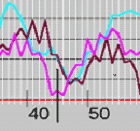
Figure 2.
|
|
| Z.I., female, 46 years old. At the age of 45 was operated for Fallopian tube cyst, additionally fibrous mastopathy was revealed. After operation her condition was satisfactory. In a few months (at the age of 46) – flu, periodontitis, exacerbation of chronic gastritis. She underwent course of antibacterial therapy. After that she had chronic pancreatitis exacerbation. Turned with complaints for bad general state. The analysis of prognosis showed decrease of energy potential on three cycles at once. Such condition in combination with noted clinical symptoms is a character one for oncological processes. However detailed examination by oncologists didn’t reveal oncological process. Subsidiary consultation by oncologists was suggested, but the patient declined it. In 2 months general condition changes to the worse and pancreatic tumor is revealed. Symptomatically treatment is suggested. Doctors refused to conduct radical therapy. Died at the age of 47.
|
| Clinical case No 2: |
|
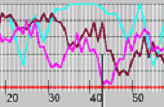 Figure 3. Figure 3.
|
|
D.A., male, 45 years old. At the age of 43 have had pneumonia. Massive antibacterial therapy was held. In 2 months – bronchitis. Underwent a second course of antibacterial therapy with slight amelioration. After that courses of antibacterial therapy were repeated several times during a year. In a year after disease (pneumonia) onset he was examined with the object to oncology. Process was found in the left lung and in the right kidney. Courses of radio- and chemotherapy were held. Turned with complains for continued general state worsening at the age of 45 years.
Analysis of prognosis showed presence of significant recession in one of the cycles at the age of 44. In this case significant role of inadequate antibacterial therapy in the development of oncological process may be supposed.
Died at the age of 45.
| Clinical case No 3: |
|
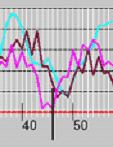 Figure 4. Figure 4.
|
|
S.L., female, 51 years old. At the age of 46 inguinal lymph nodes enlarged (the month of May). She was gynecologically examined without revelation of oncopathology. In the same year September – ascites. Tumor of both ovaries was verified. Radical operation was performed and several courses of chemotherapy during 3 years.
Feels satisfactory at present (at the age of 51).
|
| Clinical case No 4: |
|
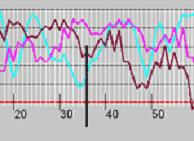 Figure 5. Figure 5.
|
|
M.G., female. At the age of 36 sigmoid colon tumor was revealed and excised. Several courses of chemotherapy were performed. In four months right ovary was removed. In three more months – the left one. Several more chemotherapy courses were performed. In half a year – ascites, doctors refused to conduct radical therapy. Died at the age of 38.
| Clinical case No 5: |
|
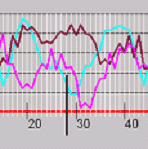
Figure 6.
|
|
M.M., male. At the age of 28 thymoma was excised. During following years complained of gastrointestinal tract’s problems and backache. Treated on he’s own. Several times went to Philippines and was treated there by healers. Died at the age of 32.
Cases examined above belong to oncological diseases. As follows from their chronobiological analysis all of them are accompanied by deep recession in one or more slow cycles. Synchronically recession in several cycles increases disease likelihood. Probability rises also because of inadequate, excessively loading therapy. It’s seen from clinical case №2 – the recession observed in one of cycles. Repeated, long-drawn antibacterial therapy apparently provoked tumor growth.
Synchronization of recessions in several cycles is not an obligatory condition of pathological process’s development, even more so of oncological process. This takes place under additional external load influence or insufficient inner reserves of organism. First symptoms of disease give warning of it. Further rational therapy and unloading allows to make the condition stable and to pass a “period of energy recession” without diseases. On the contrary, increase of load provokes conversation of pathological process into a more serious stage, but developing of oncological process is not obligative. A variant of such load may be improper therapy, for example, intensive and long-drawn antibacterial therapy. Similar clinical case is presented above (clinical case №2). Let’s take up another one.
|
| Clinical case No 6: |
|
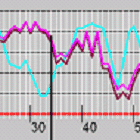 Figure 7. Figure 7.
|
|
S.A., female. At the age of 34 consulted gynecologists with complaints of episodic pains in small pelvis. Examination revealed subacute chronic process. As probable pathogens trichomonas and clarmydia were found. The course of antibacterial therapy was performed with deterioration of clinical picture. Courses of antibacterial therapy were repeated several times. Because of general state’s worsening in four months after therapy start colloid argentums medications were prescribed. After this pains in small and big joints of extremities appeared. Later on worsening of general condition is observed – pains’ aggravation in joints, skin rash (mostly on face) and mild pyrexia. Nearly in a year after therapy start (at the age of 35) diagnosis of systemic lupus erythematosus was made.
Violent intoxication on the basis of constitutional predisposition to its perception may lead to serious diseases at a background of comparatively favorable chronobiological periods (phases). In this case the course of pathological processes is more intensive.
|
| Clinical case No 7: |
|

Figure 8.
|
|
| |
S.M., female. At the beginning of March 2003 at the age of 28 had got facial nerve paresis from the right side. Received allopathic treatment without effect. In July first neurological symptoms concerning extremities showed up (right hand and leg). At the turn of October in the same year was hospitalized because of fall as a result of progressive muscle weakness. The treatment was ineffective. Disease grew progressively worse. Diagnosis of amyotrophic lateral sclerosis was made. The treatment was symptomatic. At January 2004 the patient died.
In this case the level of chronobiological recession didn’t correspond to severity of the disease. Patient’s anamnesis and the analysis her constitution showed the presence of congenital susceptibility to neuroinfection (lewetic burden). Several months before disease onset she had coitus which probably became the cause of severe lewetic intoxication. Prognosis on quicker chronobiological cycles showed great likelihood of aggravations at the beginning of May, July and November. These periods, finally, were embodied in pathologic process development.
In the case at hand constructive role of chronobiological knowledge could be in confirmation of the fact of severe infection.
Thus, longstanding analysis of rise and course of severe chronic diseases (including oncologic ones) shows significant role of chronobiological factor. Here there is a small part of cumulated data witch shows possibility of determination of “energy recession”, rise and activisation of oncopathology periods. The size of the report doesn’t allow to take up all aspects of chrono factor’s application in diagnostics, therapy and prognosis of a disease course. Real potential of chronobiology is substantially higher. We’ll list some of them:- basing on obtained data it’s possible to identify physiological and psychological fitches of a person and his type of response (loading):
– to identify peculiarities of his energy system rearrangement which was given to him at birth year by year. (Not only moments of organism’s rearrangement which common for all people, but also one’s individual fitches). Accordingly, to plan and distribute study, work, treatment and other loads.
– to determine stage and type of intoxication according to time modalities of onset and aggravation of a disease, as well as to forecast an evolution of pathological condition. |
If a doctor treats a disease and doesn’t understand the essence of the law of bloom and decadence of breath-Qi during a year, void and fullness of breath-Qi in a man, than he liberates pathogenic processes, ruins health potency of the organism, fills fullness, empties void, thereby commits a crime against the patient …
If a doctor treats diseases against the will of four seasons’ breath-Qi, which expresses in origin, growth, transformation, harvest and yield’s keeping, thereby he stands up against the will of heavens drawing troubles.
“I-Mang Fa-Lui” or “Rules and laws in medicine” |
|
|
|
|
|
|
|
